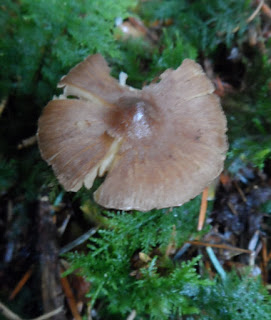Later on 10th Sept I had a short sojourn up to my local patch at Hawkes Wood once again. Something new always turns up every time I go there. I had just entered the site and tried an area not visited before but awkward to get to, and spotted Calocera cornea after turning a Hazel branch. It looked different so at home checked in the microscope and found something quite remarkable hidden away due to its size. This was very minute 'sticks' with a spore sac atop each 'stick'. Never seen before. Checking Petersen/Laesson's new publication (FTE) this turns out to be a rare small pyrenomycete called Sporothrix polyporicola. I managed to obtain a few microphotos and sent these to BMS. Only one other record I could see in UK!! Also found Botryobasidium aureum with yellow anamorphs showing well.
Later on 16th Sept I visited my local other patch at Treraven Woods, but this time heading for the nearby meadows. Last year hardly any waxcaps were recorded in Cornwall, so nice that I came across a few here in Hygrocybe conica (Blackening), Gliophorus psittacina (Parrot), G. irrigata (Slimy) and Cuphophyllus pratensis (Meadow Waxcap). Will all those lovely gorgeous professional mycologists please get these sc. names right and stick to them as it's driving all the amateur sleuths barmy!! Lastly, I found a nice group of Lactarius pyrogalus or Fiery Milkcap (named after my beloved wife) at Exmoor Zoo, oddly under a Fucshia bush soon after seeing our dearest friend Zoysha, promoted as the 'The Beast of Bodmin Moor'. This is utter rubbish as he is just a friendly beautiful black gene Leopard (not even a Panther) brought up at the zoo years ago. Still if it gets the punters in and helps the zoo ....
 |
| Russula sardonia or Primrose Brittlegill |
 |
| Russula sardonia cap cuticle |
 |
| Paxillus ammoniavirescens - 1st for SW England (11th UK - ref BMS) |
 |
| Paxillus ammoniavirescens spores |
 |
| Paxillus ammoniavirescens pleurocystidia |
 |
| Sporothrix polyporicola - note spore sac at end of stem. 2nd for UK!! |
 |
| Botryobasidium aureum with yellow anamorphs |
 |
| Hygrocybe conica or Blackening Waxcap |
 |
| Gliophorus irrigata or Slimy Waxcap (sticky) |

 |
| Gliophorus irrigata stem/gills |
 |
| Gliophorus psittacina or Parrot Waxcap |
 |
| Gliophorus psittacina gills |
 |
| Lactarius pyrogalus or Fiery Milkcap |
 |
| Lactarius pyrogalus spores |



















